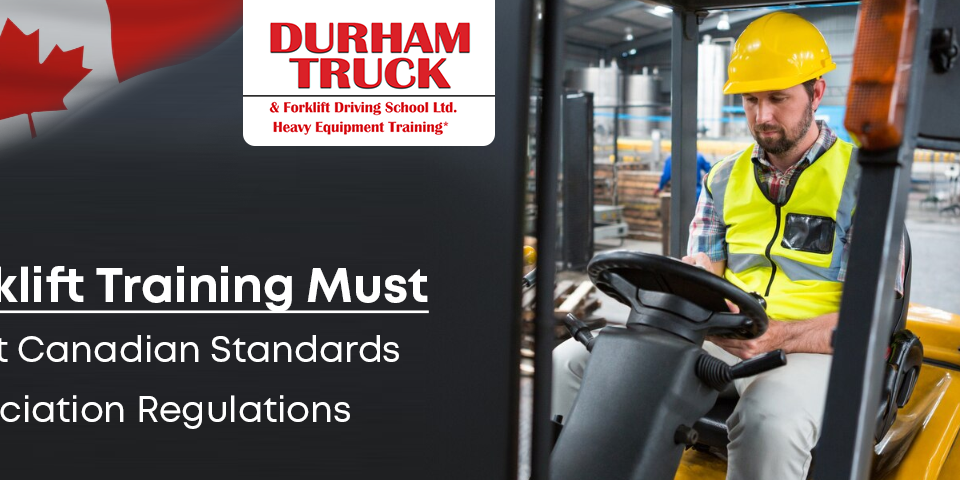Essential Skills Every Aspiring Truck Driver Needs to Master

Top 10 Safety Tips for Operating a Counterbalance Forklift
July 20, 2024
Benefits of Having a Class D License in Canada: Career Opportunities and Flexibility
August 12, 2024Truck driving is a demanding yet rewarding profession that requires a unique set of skills and knowledge. As the backbone of the logistics and transportation industry, truck drivers play a crucial role in ensuring that goods are delivered safely and on time. For aspiring truck drivers, mastering these essential skills is not just a requirement for obtaining a Commercial Driver’s License (CDL) but also for ensuring long-term success and safety. In this complete guide, we will explore the critical skills every aspiring truck driver needs to master, with insights from Durham Truck and Forklift Driving School Ltd.
- Vehicle Inspection and Maintenance
One of the most critical skills for truck drivers is the ability to perform thorough vehicle inspections and maintenance. Ensuring the truck is in optimal condition before hitting the road is vital for safety and compliance with regulations.
Pre-Trip Inspections
- Visual Checks: Inspect the vehicle’s exterior for any obvious issues, such as flat tires, broken lights, or fluid leaks.
- Under the Hood: Check engine oil, coolant levels, belts, and hoses.
- Brakes: Test the brake system, including air brakes if applicable, to ensure they function correctly.
- Load Security: Ensure the cargo is securely loaded and balanced to prevent shifting during transit.
Regular Maintenance
- Scheduled Services: Adhere to the maintenance schedule for oil changes, tire rotations, and other routine services.
- Record Keeping: Maintain accurate records of all inspections and maintenance activities to comply with DOT regulations and ensure the vehicle’s longevity.
- Driving and Maneuvering Skills
Driving a truck is vastly different from driving a regular vehicle. It requires specialized skills to handle a commercial truck’s size, weight, and unique dynamics.
Basic Driving Techniques
- Smooth Acceleration and Braking: Learn to accelerate and brake smoothly to prevent cargo shift and maintain vehicle control.
- Turning: Understand a truck’s wider turning radius and practice making wide turns without encroaching on other lanes or hitting obstacles.
Advanced Maneuvering
- Backing Up: Master the art of backing up, including straight-line backing and 90-degree alley docking, using mirrors and spotters as needed.
- Lane Changes: Safely change lanes by checking mirrors, using turn signals, and allowing sufficient space between vehicles.
- Handling Different Road Conditions: Develop the ability to drive safely in weather conditions like rain, snow, fog, and wind.
- Load Management
Proper load management is crucial for ensuring the safety and efficiency of transport. This involves understanding weight distribution, securing cargo, and adhering to weight limits.
Weight Distribution
- Axle Weight: Distribute the weight evenly across the axles to comply with legal weight limits and prevent overloading.
- Center of Gravity: Load the cargo to maintain a low center of gravity, reducing the risk of rollovers.
Cargo Securement
- Straps and Chains: Use appropriate straps, chains, and binders to secure the cargo and prevent movement during transit.
- Inspections: Regularly check the cargo and securement devices during the trip to ensure nothing has shifted or come loose.
- Safety Protocols
Safety is paramount in the trucking industry. Aspiring truck drivers must be well-versed in safety protocols to protect themselves and others.
Defensive Driving
- Awareness: Stay aware of your surroundings, anticipate potential hazards, and maintain a safe following distance.
- Speed Management: Adhere to speed limits and adjust speed according to road and traffic conditions.
Emergency Procedures
- Breakdowns: Know how to handle a vehicle breakdown safely, including using hazard lights, reflective triangles, and contacting roadside assistance.
- Accidents: Understand the steps to take in the event of an accident, including securing the scene, notifying authorities, and documenting the incident.
- Regulatory Knowledge
Compliance with federal, state, and local regulations is essential for truck drivers. This includes understanding hours of service (HOS) rules, weight limits, and safety regulations.
Hours of Service (HOS)
- Daily Limits: Know the maximum hours you can drive and be on duty daily.
- Rest Breaks: Adhere to mandatory rest breaks and off-duty periods to prevent fatigue.
Weight and Size Regulations
- Permits: Obtain necessary permits for oversized or overweight loads.
- Inspections: Be prepared for weigh station inspections and ensure your vehicle complies with all regulations.
- Communication Skills
Effective communication is vital for truck drivers, whether interacting with dispatchers, customers, or other drivers.
Radio Communication
- CB Radio: Learn to use CB radio to communicate with other truck drivers about road conditions, hazards, and general information.
- Professional Language: Use clear and professional language during all communications to avoid misunderstandings.
Customer Interaction
- Delivery Coordination: Communicate effectively with customers to coordinate delivery times and locations.
- Issue Resolution: Handle any issues or delays professionally and provide timely updates to customers and dispatchers.
- Time Management
Efficient time management is crucial for meeting delivery deadlines and maximizing productivity.
Route Planning
- GPS and Maps: Utilize GPS and maps to plan the most efficient routes, considering factors like traffic, road conditions, and delivery windows.
- Fuel Stops: Plan fuel stops and rest breaks to minimize downtime and maintain a steady schedule.
Logistics Coordination
- Load and Unload Times: Coordinate with loading and unloading facilities to streamline the process and reduce waiting times.
- Document Management: Keep track of all necessary documents, such as delivery receipts and logbooks, to ensure smooth operations.
- Problem-solving and Adaptability
Truck drivers often encounter unexpected situations on the road. Thinking on your feet and adapting to changing circumstances is a valuable skill.
Mechanical Issues
- Basic Repairs: Learn to handle minor repairs and troubleshooting, such as fixing a flat tire or addressing engine issues.
- Emergency Kits: Carry an emergency kit with essential tools and supplies to address common problems.
Route Changes
- Detours: Adapt to route changes due to construction, accidents, or weather conditions, and find alternative routes quickly.
- Delays: Manage delays by communicating with dispatch and customers adjusting schedules as needed.
Conclusion
These essential skills are crucial for aspiring truck drivers to succeed in the industry. At Durham Truck and Forklift Driving School Ltd., we emphasize a comprehensive training program covering all these areas, ensuring that our students are well-prepared for their careers. By focusing on vehicle inspection and maintenance, driving and maneuvering skills, load management, safety protocols, regulatory knowledge, communication, time management, problem-solving, and technological proficiency, our graduates are equipped to handle the challenges and responsibilities of professional truck driving. Whether you’re just starting or looking to enhance your skills, our experienced instructors and state-of-the-art training facilities support your journey to becoming a skilled and confident truck driver.




